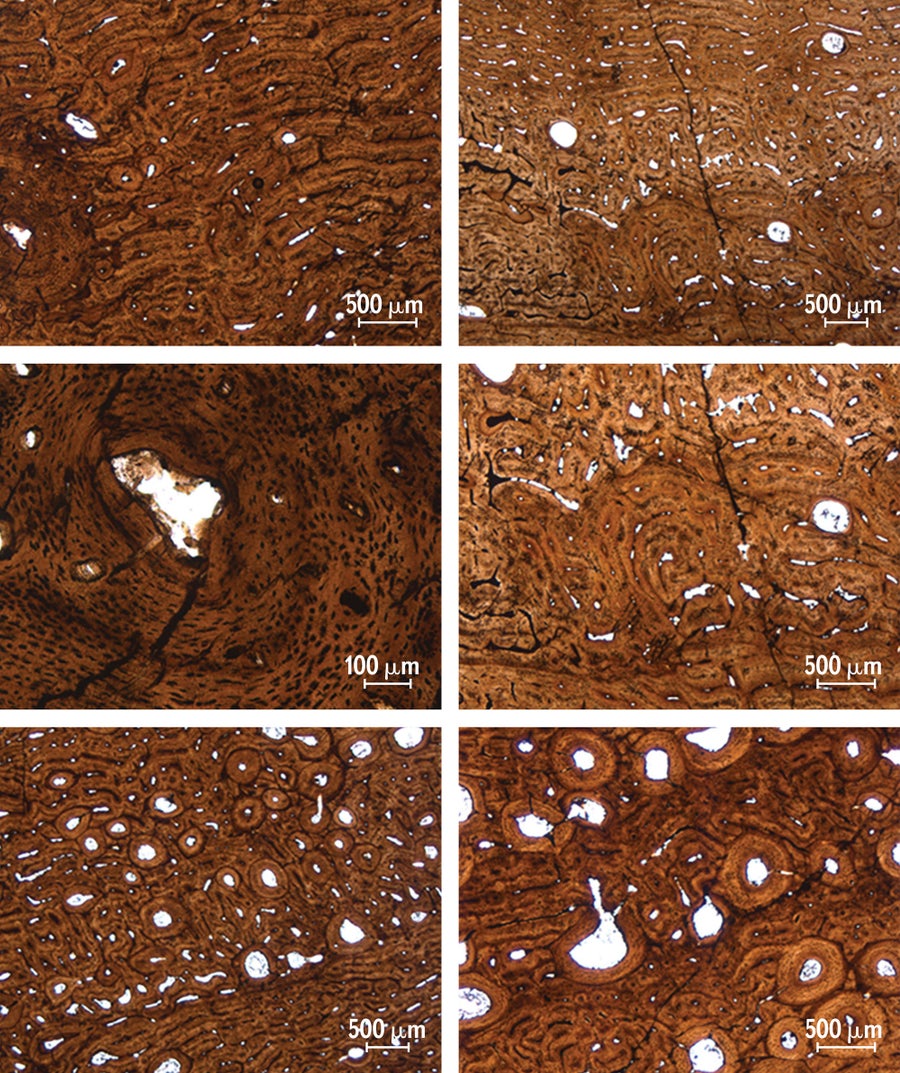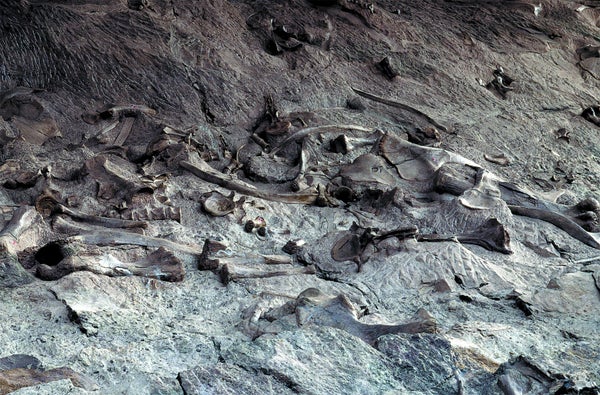The Intermountain West is positively littered with dinosaur boneyards. In Late Jurassic rock layers from New Mexico to Montana, paleontologists have uncovered deposits that look like skeletal logjams.
Whether connected or jumbled in a pile, the bones of prehistoric icons such as Allosaurus, Stegosaurus, Diplodocus, and more are often found in abundance—the result of Jurassic monsoon floods that washed multiple individuals and species together into great heaps, covering them with sediment that let them petrify. What might seem like a scientific bonanza, however, can quickly turn into an Apatosaurus-sized headache for experts trying to unscramble the details of prehistory from these osteological accumulations.
“How many dinosaurs are we looking at?” might seem like a simple question, but paleontologists know differently. Every dinosaur skeleton, large or small, comprises 200 or more bones. As the Late Jurassic bonebeds formed, those skeletons did not always stay connected (“articulated”) or close together (“associated”). Decay, scavengers and the force of the sediment-carrying floodwaters fragmented and scattered the remains. In places such as central Utah's Cleveland-Lloyd Dinosaur Quarry, there are no complete articulated skeletons. Paleontologists estimate the site holds the remains of at least 46 Allosaurus—only because they have identified 46 left femora, or thigh bones, from this species there.
On supporting science journalism
If you're enjoying this article, consider supporting our award-winning journalism by subscribing. By purchasing a subscription you are helping to ensure the future of impactful stories about the discoveries and ideas shaping our world today.
Such estimates are only minimums, however, as some animals' left femurs are likely missing. A similar situation holds true for other prehistoric bonebeds, too. “Up until now, the main assignment of bones to an individual was made based on whether the bones were found articulated or associated,” says University of Bonn graduate student Kayleigh Wiersma-Weyand. Paleontologists typically assume nearby bones of the same species and of comparable size belong to the same animal, but there has been no effective way to test this idea. Now Wiersma-Weyand and her colleagues offer a solution, published in Palaeontologia Electronica: look inside the bones.
Wyoming's Howe-Stephens and Howe Scott Quarries have long been hotspots for paleontologists. But like other famously productive Jurassic bonebeds in the West, the remains in these rocks were strewn together prior to burial. By examining the bones' microscopic cellular structure, however, the researchers were able to match isolated bones to identified individuals.

Microscopic views of structures in the femur of an Apatosaurus nicknamed “Jacques,” including vascular canals and signs of newer bone growth. Source: “Testing Hypothesis of Skeletal Unity Using Bone Histology: The Case of the Sauropod Remains from the Howe-Stephens and Howe Scott Quarries (Morrison Formation, Wyoming, USA),” by Kayleigh Wiersma-Weyand, Aurore Canoville, Hans-Jakob Siber and P. Martin Sander, in Palaeontologia Electronica, Article Number: 24.1.A10 https://doi.org/10.26879/766, Copyright Society for Vertebrate Paleontology, March 2021
Team members thinly sliced core samples of long-necked sauropods' limb bones to examine under the microscope. (Bones' overall structure can be preserved after this sampling process, if done carefully.) Their study is the first to combine several types of microstructure analysis to narrow down which bones go with which skeleton. The technique involves examining features such as growth lines, the number of openings for blood vessels in bone tissue, and circular structures where new tissue has grown to replace old.
“I think this is a clever approach to a common problem,” says Adelphi University paleontologist Michael D'Emic, who was not involved in the new study. It can be difficult, especially in historical collections made decades ago, to tell whether a particular bone matches others found at the same site or was buried as an isolated piece. Some dinosaur skeletons displayed in museums have been reconstructed from multiple isolated bones from the same spot, without a way to check if all those parts belonged to one animal or several. “This paper opens up a new approach to determining which individual is which,” D'Emic says—provided museums allow the necessary bone sampling.
The new study builds on decades of research into how a dinosaur's bones record its growth and life. That research focused on diverse bones from many locations, Wiersma-Weyand says, “but now we can apply our general insights to specific deposits.”
In the case of a sauropod nicknamed “Max,” for example, nearly all the bones were found in a disarticulated pile. Two of the lower leg bones were still together—but did the other isolated bones belong to this Galeamopus? The researchers found that structural details in the articulated bones matched those in many of the disarticulated ones, suggesting they belonged to the same individual. But the scientists also discovered that some bones, previously assigned to Max based on their appearance alone, actually belonged to other animals. Thus, they narrowed down Max's precise skeleton more than 148 million years after the dinosaur's death.
The study does have some limitations. “Different elements of a [single] skeleton have different biomechanical constraints and preserve slightly different biomechanical profiles,” says Museums of Western Colorado paleontologist Julia McHugh, who was not involved in the new research. While acknowledging this, Wiersma-Weyand notes that her team's process is sometimes more powerful in determining which bones do not go together. Starting with bones that are still articulated or associated helps to set a baseline for attributing additional bones. The multiple lines of microscopic analysis work best to test a hypothesis about whether bones belong to the same animal.
Using microscopic structure to identify which bones belong to which dinosaurs has applications beyond better estimating how many individuals are in a deposit, McHugh says—and perhaps beyond dinosaurs, too. “This could be very useful for determining age profiles of populations in individual bonebeds,” whether they are Jurassic dinosaurs or fossil mammals, she says.
This approach can also help reveal how these remains came to be where they are, Wiersma-Weyand says. In a petrified river channel, for instance, matching bones to specific dinosaurs can help paleontologists identify the direction the water was flowing when the bones were buried. This is key for reconstructing how bonebeds formed and for determining whether they record one burial incident or many.
“It's pretty exciting!” says University of Wisconsin–Oshkosh paleontologist Joseph Peterson, who was not involved with the study. “Being able to reconstruct how multiple skeletons disarticulated in conjunction with the environment they are buried in would bring aspects of modern forensic and crime-scene analysis to paleontology.”
